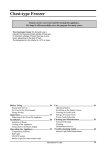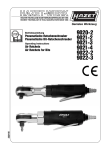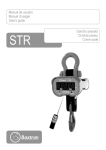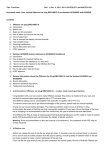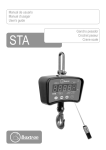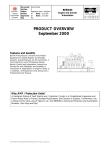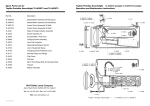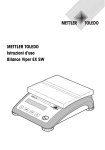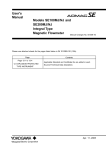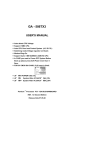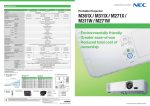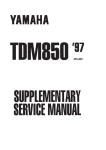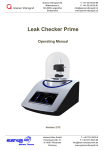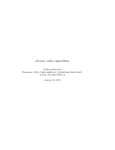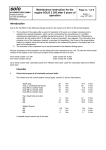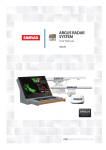Download 1. TECHNICAL SPECIFICATIONS & OPERATION MANUAL The
Transcript
Gas Admission Valve GAV-40 Manual and Operation Instruction 1. TECHNICAL SPECIFICATIONS & OPERATION MANUAL The GAV solenoid operated gas admission valve is designed for use on four-cycle turbo-rcharged engines to govern the required amount of fuel admitted into the inlet port of the cylinder head depending on engine speed and load. To govern the required amount of gas by means of the GAV, the INCON electronic control system must be used for the valve control. The engine load and speed are governed by the amount of gas admitted into the inlet port which is proportional to the duration of the GAV valve opening. The GAV valve must assure rapid valve opening and closing (a fast response to the control signal) together with reliable valve opening for the whole requested period of time. Consequently, the GAV valve features short travel, the moving valve plate is opened by the solenoid force and closed by the spring force together with gas pressure. The design provides a complete seal in the closed position of the valve. Caution: The GAV valve must not be used as a shut off valve. To serve this purpose, an independent shut off gas valve must be installed. Technical Specifications: Operating voltage Cross-sectional area of flow Lift Working medium Switching frequency Response (assumes the use of an INCON control) - time to full open - time to full closed Ambient temperature (permanently) Ambient temperature (short-term) Protection class Classification for use in atmospheres: Max. gas supply pressure Max. Air manifold pressure Max. gas pressure difference Max. Backfire pressure Inlet gas temperature Solenoid core resistance W:\DOKUMENTATION 2\Gas Motoren\GAV\Dokumentation\4014-V1.0-Gas Admission Valve GAV 40 Specifications-06-11-01-dh-en.doc 150 VDC 700 sq.mm 0.9 mm Gaseous fuel (natural gas etc.) 12.5 Hz max. 0.003 s max. 0.003 s max. -40…..+100 °C 125 °C max. IP 64 Non-explosive atmosphere 500kPa (5 bar) 300kPa (3 bar) 200kPa (2 bar) 50kPa (0.5 bar) 60 °C max. 38.4 Ω +/- 5% 4014-V1.0 03.11.2006 mh/dh Page 1 of 14 Gas Admission Valve GAV-40 Manual and Operation Instruction 2. INSTALLATION, OPERATION, MAINTENANCE The GAV valve installation 1. The GAV valve Installation, Operation and Maintenance Manual must be read carefully prior to installation. 2. The GAV valve can be mounted on the manifold in any position. 3. Make sure that the O-ring at the valve inlet and outlet is clean and properly located. 4. Evenly and gradually tighten the M8 mounting screws to max. torque (20 Nm). Use a lock-washer in accordance with DIN 137 A. 5. The solenoid operated valve is controlled by a cable with a square section of 1.5mm2. The mating connector type DIN 43650 comes along with the valve. 6. The gas inlet hole is recommended to be equipped with a flexible hose (mounted through an adapter) to avoid unnecessary stress affecting the valve body. Mount and tighten the flexible hose on the adaptor prior to its installation on the valve. 7. After installation, all joints which can be dismantled (including the inlet and outlet flange), must be checked for gas leaks e.g. by means of a foam-forming agent. MAINTENANCE, TROUBLESHOOTING Provided that good gas filtration, in accordance with the technical parameters has been assured, the valve does not need any maintenance. Should any valve defect be found (leakage, failure to function etc.) the valve has to be replaced. Don’t repair a valve without the appropriate service instruction and the necessary knowledge. Should leakage exceed allowed limits, the valve is disassembled (as instructed) so that sealing surfaces of the valve can be checked and cleaned. After assembly, the valve closing tightness test is repeated and evaluated. Caution: The valve seat can be cleaned on the contact surface by lapping or sand paper on a flat plane. The moving plate should never be cleaned by lapping or sand paper. Within the warranty period, repairs of the valve may be carried out by the valve manufacturer only. W:\DOKUMENTATION 2\Gas Motoren\GAV\Dokumentation\4014-V1.0-Gas Admission Valve GAV 40 Specifications-06-11-01-dh-en.doc 4014-V1.0 03.11.2006 mh/dh Page 2 of 14 Gas Admission Valve GAV-40 Manual and Operation Instruction RECOMMENDED MAINTENANCE INTERVALS 2000 hours of operation Operational check of all valve joints which may be dismantled for leakage, including inlet and outlet flange: the valve is mounted on the engine and the check is made by means of a gas leakage detector or foam-forming agent. 3000 hours of operation Valve leakage check and valve closing tightness check in accordance with instructions. 6000 hours of operation Valve O-rings replacement. Cage assembly replacement Lower valve plate replacement Recommended Replacement Parts O-ring set (positions 14 and 15) Cage assembly (position 2,3,4 and 5) Lower valve plate (position 6) Accessories supplied with the valve O-Ring: 46 X 2 (Pos. 14) O-Ring: 64.77 X 2.62 (Pos. 15) Mating Connector: EC 1120, DIN 43650 Packaging, Transport, Storage The solenoid operated valve is packed in a polyethylene bag. In transit and storage, the packed product must be protected against mechanical damage. If possible, valves should be stored indoor and protected against weather and other effects to avoid their contamination, damage and deterioration. Warranty The manufacturer provides a Warranty for the purchased GAV valves which expires upon the earliest of 12 months from delivery or 2000 hours of operation. Data for Delivery The order has to specify: The number of units. Valve type (preliminary consultation with the manufacturer is advisable). For accessories, the replacement parts order should include a position in accordance with an outline drawing and parts list and if you need replacement parts for the valve purchased, specify the valve serial number. W:\DOKUMENTATION 2\Gas Motoren\GAV\Dokumentation\4014-V1.0-Gas Admission Valve GAV 40 Specifications-06-11-01-dh-en.doc 4014-V1.0 03.11.2006 mh/dh Page 3 of 14 Gas Admission Valve GAV-40 Manual and Operation Instruction TESTING Valve closing tightness test 1. The valve is checked under conditions and with equipment corresponding with its operation. 2. The test substance is filtrated (5 micrometer) air with 2 bar pressure. 3. The testing equipment consists of the test substance source (air with filtration of 5 micrometers) and 2 bar pressure and connecting piping (DN 10 mm) with a pressure gauge for measuring the valve inlet pressure. 4. Criteria of allowed GAV valve closing tightness: Opening of the valve plate not before 0.5 bar. Leakage test For a leakage test, an air pressure source with the highest working pressure (2 bar) will be used. The test substance supply will be connected to the inlet part of the valve. Leakage will be considered as satisfactory if within 3 minutes no measurable or visible (foam-forming agent) leakage is detected, which is equal to zero pressure drop once the inlet pressure ball valve is closed. Supporting Documents • Declaration of Conformity • Dimensional drawing • Section drawing and parts list • Valve Test Record Sheet with attached graph on valve travel measurement related to time (functional test) • GAV 40 valve Disassembly and Assembly Instructions (for replacement of main parts) Prepared by: Daniel Huegli & Bernhard Suter Date: November 29.2006 W:\DOKUMENTATION 2\Gas Motoren\GAV\Dokumentation\4014-V1.0-Gas Admission Valve GAV 40 Specifications-06-11-01-dh-en.doc 4014-V1.0 03.11.2006 mh/dh Page 4 of 14 Gas Admission Valve GAV-40 Manual and Operation Instruction DECLARATION OF CONFORMITY Manufacturers Name Huegli Tech AG (Ltd.) Manufacturers Address Murgenthalstrasse 30, CH-4900 Langenthal Model Name/Number Gas admission valves, GAV – 20, GAV – 40 Product Description and Function: The GAV solenoid-operated gas admission valve is designed for use on four-cycle supercharged gas engines to govern the required amount of fuel admitted into the inlet runner of the cylinder head depending on engine speed and load. The product is intended for use in non-explosive atmospheres. The solenoid operated gas admission valve must not be used as a stop valve (safety valve). We hereby declare and confirm that A. The specified product is safe under conditions of its ordinary and intended use (as described in its Operation Manual) and actions have been taken to assure conformity of all launched products with technical specifications, basic relevant regulatory requirements and requirements of technical regulations specified in Section B. B. The characteristics of the product meet all applicable technical requirements set out in: 1. 94/9/EC Council directive of March 1994 on the approximation of the laws of the member states concerning equipment and protective systems intended for use in potentially explosive atmospheres 2. 73/23/EEC council directive of February 1973 on the harmonization of the laws of the member states relating to electrical equipment designed for use within certain voltage limits. 3. EN 60204-1: Safety of machinery – Electrical equipment of machines EN 60204-1 4. EN 61010-1: Safety requirements for electrical equipment for measurement, control and laboratory use - Part 1: General requirements 5. EN50028: Electrical apparatus pro potentially explosive atmospheres Part 8 We, the undersigned, herby declare that the equipment specified above conforms to the above directive(s). Manufacturer Full name Daniel Huegli Position President Place CH-4900 Langenthal, Switzerland Date 1. November 2006 W:\DOKUMENTATION 2\Gas Motoren\GAV\Dokumentation\4014-V1.0-Gas Admission Valve GAV 40 Specifications-06-11-01-dh-en.doc 4014-V1.0 03.11.2006 mh/dh Page 5 of 14 Type Serie HUEGLI TECH AG (LTD) 4900 LANGENTHAL SWITZERLAND W:\DOKUMENTATION 2\Gas Motoren\GAV\Dokumentation\4014-V1.0-Gas Admission Valve GAV 40 Specifications-06-11-01-dh-en.doc 4014-V1.0 03.11.2006 Rev Date Name 2.3 kg Date 25.11.05 Name bs HUEGLI TECH AG 4900 Langenthal Switzerland Scale Drawn Appr. Weight Customer Drawing Nr. Document: GS-1360 Gas Admission Valve Dimensional Drawing GAV-20-S2 / GAV-40-S2 Gas Admission Valve GAV-40 Manual and Operation Instruction DIMENSIONAL DRAWING mh/dh Page 6 of 14 W:\DOKUMENTATION 2\Gas Motoren\GAV\Dokumentation\4014-V1.0-Gas Admission Valve GAV 40 Specifications-06-11-01-dh-en.doc Rev Date Name 4014-V1.0 03.11.2006 Date 01.11.06 O-Ring 66X2 O-Ring 68X2 O-Ring 62X2 O-Ring 46X2 1 1 1 1 1 13 14 15 16 Allen screw M5X35 BN3 1 4 1 4 20 21 22 23 Name kzj Valve top with coil 1 19 Allen screw M5X16 BN3 18 Customer Drawing Nr. Document: GS-1492 General Assembly GAV-40-S2 Screw M3X10 BN330 Connector socket Gasket Lock-washer M5 BN782 4 8 17 Pin 2.5X5 BN1208 O-Ring 64.77X2.62 Closing flange Lower valve disk 12 HUEGLI TECH AG 4900 Langenthal Switzerland Scale Drawn Appr. Weight Valve plate Screw M6X20 1 1 6 7 Spring Disk 10 1 5 Cage 1 1 4 1 1 3 Valve housing Armature 9 1 2 DESIGNATION BENENNUNG 8 1 1 1 QTY. ANZ. ITEM POS. Gas Admission Valve GAV-40 Manual and Operation Instruction SECTION DRAWING AND PARTS LIST mh/dh Page 7 of 14 Gas Admission Valve GAV-40 Manual and Operation Instruction VALVE TEST RECORD SHEET WITH ATTACHED GRAPH ON VALVE TRAVEL MEASUREMENT RELATED TO TIME (FUNCTIONAL TEST) W:\DOKUMENTATION 2\Gas Motoren\GAV\Dokumentation\4014-V1.0-Gas Admission Valve GAV 40 Specifications-06-11-01-dh-en.doc 4014-V1.0 03.11.2006 mh/dh Page 8 of 14 Gas Admission Valve GAV-40 Manual and Operation Instruction Service Manual for GAV valves Tools required: Allen key Nr. 4; Screwdriver Nr. 7 and Loctite 743 blue Clamp the GAV on the coil side in a vice. Hand tighten the vice Remove the 4 allen screws holding the end flange Rotate the end flange until it can be removed After removing the end flange, open the vice and turn the GAV upside down until the assembled cage falls out. Note: Don't drop the cage from a too high altitude, since it could damage the rubber valve plate. W:\DOKUMENTATION 2\Gas Motoren\GAV\Dokumentation\4014-V1.0-Gas Admission Valve GAV 40 Specifications-06-11-01-dh-en.doc 4014-V1.0 03.11.2006 mh/dh Page 9 of 14 Gas Admission Valve GAV-40 Manual and Operation Instruction Clamp the cage in to the vice between the anker plate. Note: Don't overtorque the vice as the anker plate could suffer damage. It is recommended to use soft vice clamps. Unscrew the centre screw until the rubber plate can be removed. Disassemble the complete cage. Make sure all parts are cleaned before inspection. Use non aggressive petrol for cleaning the parts. W:\DOKUMENTATION 2\Gas Motoren\GAV\Dokumentation\4014-V1.0-Gas Admission Valve GAV 40 Specifications-06-11-01-dh-en.doc 4014-V1.0 03.11.2006 mh/dh Page 10 of 14 Gas Admission Valve GAV-40 Manual and Operation Instruction Inspect the rubber valve plate. On top see a used plate, which still can be used. Below see a new valve plate. Important is to watch out for cracks and tear in the rubber surface. However, small holes which are not larger than 0.5mm and are not located on the sealing ring-marks do not affect the operation. Plate which was in operation. The 6 visuable rings mark the sealing plate. As long these have no infringement, the valve plate still meets specification. W:\DOKUMENTATION 2\Gas Motoren\GAV\Dokumentation\4014-V1.0-Gas Admission Valve GAV 40 Specifications-06-11-01-dh-en.doc New valve plate which has never been in use. No ring markings can be seen. 4014-V1.0 03.11.2006 mh/dh Page 11 of 14 Gas Admission Valve GAV-40 Manual and Operation Instruction In order to make sure the lower valve plate is cleaned properly, use a lapping disk or a very fine sand paper. In case sand paper is used, the grit number has to be between 280-320. Use a flat even surface without any bumbs. Smoothly push the lower valve plate up and down with the sealing surface facing the sand paper. Repeat the movement until the surface of the valve is clean. It is important that only a few tenth of a millimetre of the peak radius shape are cleaned in order to seal properly. IMPORTANT NOTE: After lapping or using a sand paper, clean the lower valve plate toroughly and assure that there are no particulates left over from the sand paper. Assemble the complete cage. Loctite shall be used on the rubber plate screw, Loctite Nr. 743 blue. Tighten the rubber plate. Therefore use a large screwdriver Nr.7 and tighten firmly. Before inserting the cage in to the valve body, ensure the inside of the valve is cleaned and no particulates remain on the coil surface. W:\DOKUMENTATION 2\Gas Motoren\GAV\Dokumentation\4014-V1.0-Gas Admission Valve GAV 40 Specifications-06-11-01-dh-en.doc 4014-V1.0 03.11.2006 mh/dh Page 12 of 14 Gas Admission Valve GAV-40 Manual and Operation Instruction Then insert the cage assembly. There is only one direction to insert the cage since inside the valve housing a pin is located, which has to match to the cage slit. Slide the cage in to the valve. If it does not go all the way down, it is possible to twist the cage by hand from the gas inlet side until the cage slides in to the valve completely. Insert the valve end plate. Before the end flange is mounted, make sure that the 2 O-rings are properly installed. Make sure that the O-rings are in good shape, otherwise replace them. It is recommended to use a fingertip of grease to smoothen the O-rings. Tighten the end flange with an allen key Nr. 4, torque, 7.5NM. W:\DOKUMENTATION 2\Gas Motoren\GAV\Dokumentation\4014-V1.0-Gas Admission Valve GAV 40 Specifications-06-11-01-dh-en.doc 4014-V1.0 03.11.2006 mh/dh Page 13 of 14 Gas Admission Valve GAV-40 Manual and Operation Instruction Before mounting the valve on to the engine, be assured that the O-Ring facing the engine is in good shape and has no infringement. Also use a finger tip of grease to smoothen the O-ring. Mounting the valve on the engine block, make sure that the mounting surface is cleaned before positioning the valve. The 4 M8 nuts are tightened with 20 NM each. W:\DOKUMENTATION 2\Gas Motoren\GAV\Dokumentation\4014-V1.0-Gas Admission Valve GAV 40 Specifications-06-11-01-dh-en.doc 4014-V1.0 03.11.2006 mh/dh Page 14 of 14














